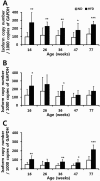Measurement of altered APP isoform expression in adipose tissue of diet-induced obese mice by absolute quantitative real-time PCR
- PMID: 30460057
- PMCID: PMC6138354
- DOI: 10.1080/19768354.2017.1290679
Measurement of altered APP isoform expression in adipose tissue of diet-induced obese mice by absolute quantitative real-time PCR
Abstract
Obesity is associated with increased risk of Alzheimer's disease. Previous studies have demonstrated that amyloid-beta precursor protein (APP) is expressed in subcutaneous adipose tissue (SAT), upregulated with obesity, and correlates with insulin resistance and adipose tissue inflammation. APP is alternatively spliced into several isoforms, which may be indicative of the pathogenesis of APP-related diseases, but the accurate quantification has been difficult to standardize and reproduce. In light of this, we developed isoform-specific absolute cDNA standards for absolute quantitative real-time PCR (AQ-PCR), and measured transcript copy numbers for three major APP isoforms (APP770, APP751, and APP695), in SAT from C57BL/6 mice fed either a normal or high-fat diet. Expression of all three major APP isoforms was increased in diet-induced obese mice. Transcript copy numbers of APP770 and APP695 correlated with plasma insulin and CCL2 gene expression. The ratios of APP770 and APP751 to APP695 gradually decreased with aging, and correlated with plasma glucose levels. In addition, APP770 was significantly decreased in thiazolidinedione-treated mice. We describe quantification of APP isoform transcripts by AQ-PCR, which allows for direct comparison of gene copy number across isoforms, between experiments, and across studies conducted by independent research groups, which relative quantitative PCR does not allow. Our results suggest a possible role of differential expression of APP isoforms in the development of obesity-related insulin resistance and adipose tissue inflammation. In addition, it is important to determine if altered ratios of APP isoforms in SAT contribute to higher circulating Aβ peptides and increased risk of abnormalities in obesity.
Keywords: Alternative splicing; absolute quantitative real-time PCR; adipose tissue; amyloid-beta precursor protein (APP); obesity.
Figures





Similar articles
-
Plasma amyloid-beta peptide levels correlate with adipocyte amyloid precursor protein gene expression in obese individuals.Neuroendocrinology. 2009;90(4):383-90. doi: 10.1159/000235555. Epub 2009 Aug 12. Neuroendocrinology. 2009. PMID: 19672057
-
Thyroid hormones regulate beta-amyloid gene splicing and protein secretion in neuroblastoma cells.Endocrinology. 1998 Jun;139(6):2692-8. doi: 10.1210/endo.139.6.6033. Endocrinology. 1998. PMID: 9607774
-
Amyloid precursor protein expression is upregulated in adipocytes in obesity.Obesity (Silver Spring). 2008 Jul;16(7):1493-500. doi: 10.1038/oby.2008.267. Epub 2008 May 15. Obesity (Silver Spring). 2008. PMID: 18483477
-
Estradiol regulates APP mRNA alternative splicing in the mice brain cortex.Neurosci Lett. 2005 Jun 10-17;381(1-2):154-7. doi: 10.1016/j.neulet.2005.02.014. Epub 2005 Feb 25. Neurosci Lett. 2005. PMID: 15882808
-
The amyloid precursor protein: a biochemical enigma in brain development, function and disease.FEBS Lett. 2013 Jun 27;587(13):2046-54. doi: 10.1016/j.febslet.2013.05.010. Epub 2013 May 16. FEBS Lett. 2013. PMID: 23684647 Review.
Cited by
-
Neprilysin-Mediated Amyloid Beta Clearance and Its Therapeutic Implications in Neurodegenerative Disorders.ACS Pharmacol Transl Sci. 2024 Sep 24;7(12):3645-3657. doi: 10.1021/acsptsci.4c00400. eCollection 2024 Dec 13. ACS Pharmacol Transl Sci. 2024. PMID: 39698259 Review.
References
-
- Barrachina M, Dalfo E, Puig B, Vidal N, Freixes M, Castano E, Ferrer I. 2005. Amyloid-beta deposition in the cerebral cortex in dementia with Lewy bodies is accompanied by a relative increase in AbetaPP mRNA isoforms containing the Kunitz protease inhibitor. Neurochem Int. 46:253–260. doi: 10.1016/j.neuint.2004.08.006 - DOI - PubMed
-
- Bush AI, Martins RN, Rumble B, Moir R, Fuller S, Milward E, Currie J, Ames D, Weidemann A, Fischer P, et al. . 1990. The amyloid precursor protein of Alzheimer’s disease is released by human platelets. J Biol Chem. 265:15977–15983. - PubMed
LinkOut - more resources
Full Text Sources
Research Materials
